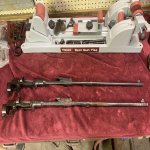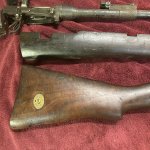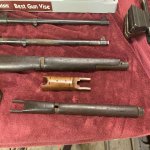I have been trying to "clean up" various cosmoline immersed stocks for a while - particularly the cleaning rod hole in a Swede Mauser is a "bear" to get that stuff out. As per an acquaintance, he uses hot water and Simple Green detergent to "wash" that stuff off, but have to be careful not to get the wood fibres soaked with water, or they swell when they dry - and make little feathers or hairs that most often need to be scraped or sanded off. I have used Varsol and Acetone to try to cut through that crap. Much paper towel and many Q-tips. Many stocks have had bad dark bruising and marks - I gave up to clean some of that, and used Circa 1850 paint and varnish remover to strip that - sometimes previous owners will slather a finish on top of the wood - may as well get that gone. Most original stocks, I think, were treated with linseed oil, or some variation of that - soaked INTO the wood fibres, not on top of them. Hand sweat and grime from the gripping areas tends to be dark - takes some soaking with acetone (?), then sprinkle with like baking soda to "suck" those oils out of the wood. In several cases, after cleaning, I mix perhaps 50% Red Mahogany MinWax stain with 50% boiled linseed oil and apply that to try to get hand guards, front and rear buttstocks to all get to similar colour. Downside (?) of linseed oil is that it darkens as it gets worked on by oxygen in the air - so in four or five years it will be darker than what you have today. Original stuff applied in WWI might be VERY dark today - is not slam dunk easy to match to that. I am sure whole books could be written about restoring wood - removing wrong finish, using steam to "plump up" dents, how to apply linseed oil, and so on.
On a particular project, was some rust stains soaked into the wood. Internet lead me to "Bar Keepers Friend" - active ingredient is oxalic acid - was able to get some nearly pure stuff on Amazon.ca - and it worked - it does lift those rust stains, but bleaches the wood fibres to nearly white while doing so - so you have to be prepared to re-stain that area, if you use that stuff.












































































